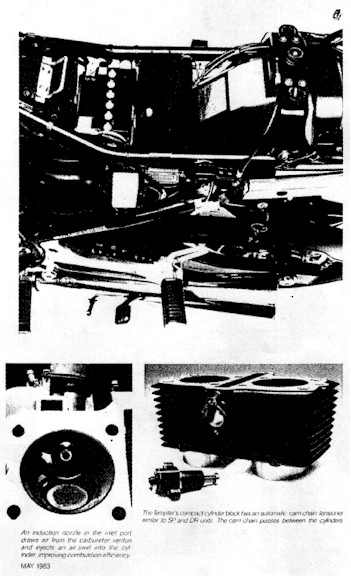| reprinted from the May 1983 issue of Cycle Magazine | |||
|
tubes extend rearward from the steering head, briefly paralleling the back bone (standard practice), then jut rearward, forming the seat platform. Even the single-shock XN85 Turbo doesn't employ a layout like this, but the XN pumps out a frame-testing 71 horsepower; the GR ekes out 38. The box-section swing arm incorporates Suzuki's Full Floater suspension system. Two short uprights transfer the arm's motion to one end of a rocker; the shock's top-end connects to the |
rocker's rocker's other end, and the shock bottom mounts to an extension below the swing arm. A remote preload adjuster sits just under the right carburetor, but the shock has no provision for damping adjustment or an air assist. The screw-type adjuster controls hydraulic pressure to a piston above the shock's spring. Screwing the knob clockwise raises pressure, and the piston bears down against the spring and increases spring preload. It's a fine-thread adjustment: changing from full- |
soft to full-hard takes about 20 turns. The knob's proximity to the crankcase means it must be turned in ninety-degree increments and, as the springing gets stiffer, the knob-twisting gets harder. We would prefer a quicker method of preload adjustment. The GR's springing is biased toward sport riding, though the ride is less stiff-legged than some strictly sport machines. Fork compliance is good over most surfaces, firm only in the last few inches of travel. The rear suspension is quite firm over it's full range - small-bump compliance is mediocre even at low preload settings. Medium bumps, the kind encountered on an average highway, produce a choppy ride, and large bumps (such as potholes and ledges) jolt the rider. The suspension is well suited for carrying a load; a passengers weight smoothes the ride. The stiff springing does benefit ground clearance though. Soft-springing usually handicaps a rider cornering hard on a light machine. On the GR, even aggressive riders will frighten themselves before touching any hard parts, while more sedate riders will find excellent ground clearance even with the suspension on full-soft settings. The GR's precise steering lets the rider hustle the nimble Tempter in and out of corners with ease; left to right switchbacks require less effort than with most in-line fours. Even as the rider brakes hard into a corner's apex, the bike turns without trying to stand up. Mid-corner bumps cause a momentary rear-end pogo that never develops into a wobble. The GR's brakes have no trouble stopping the 650. The single front disc is strong, with good feedback. The well-controlled rear drum has no tendencies toward lockup. During one session of countless zero-60-zero-mph sorties on a downhill road, the brakes never faded. Although closer to 450 size, the 650 has more room for it's rider than the average small bike. The seat composition feels softer than most other Suzuki's, and the small seat step is located sufficiently rearward to avoid fouling the backsides of our largest staffers. The seat narrows towards the front soshorter riders can slide forward to reach the pavement at stops. Both handlebar and footrests are well positioned for short and tall riders. Rubber-mounted bar and pegs control vibration to about 4500-4600 rpm. Certainly this 650 feels like an average four. At 4700 rpm, 62 mph in high gear, vibration seeps through the handlebar, seat and pegs. Though less intense than some twins, the GR's will make the rider's hands tingle after a while. Don't exceed 62 mph, and you can cruise comfortably. Although some vibration greeted our | |
|
| |||
